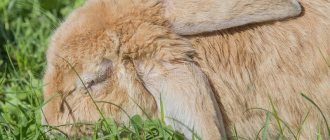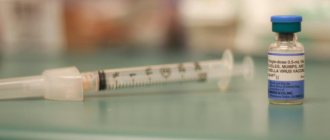Vaccinations. Need advice.
Vaccinations. Need advice. ¶
From: nady - April 6, 2008 16:32
Dear breeders! This question has arisen. Is it possible for pigs to receive vaccinations that are intended for rabbits? A veterinarian I know said that there is a massive death rate of guinea pigs in Moscow. The symptoms are almost identical for everyone. Mostly females and cubs die, less often males. The animal becomes lethargic, lies down more, some lose their hind legs, etc. He believes that this is a viral infection and advised vaccinating pigs with a vaccine for rabbits. There is a version that it was a mutated rabbit disease virus, VGBV. I don’t claim that this is really true, but there is such a version. Share your experience and opinions.
Vaccinations. Need advice. ¶
From: Businda - April 6, 2008 4:37 pm
Case. Where is the case? Breeders, owners! This is true. Who has a case? I'm really worried
Vaccinations. Need advice. ¶
From: nady - April 6, 2008 4:42 pm
I was told this information when I went to get my dog vaccinated. At the same time I asked if it was possible to vaccinate pigs? To which I was given this answer.
Vaccinations. Need advice. ¶
From: KsyuKha - April 6, 2008 18:20
Pigs are not vaccinated, especially not with a vaccine for rabbits. Pigs do not get this disease.
People began to have more mumps, and accordingly they began to bring in more sick people. It is necessary to feed a more balanced food for each age.
Vaccinations. Need advice. ¶
From: nady - April 6, 2008 6:30 pm
What about small nurseries or those who have 1-2 pigs? The feeding there is very good. Many sinned on food, many switched to high-quality imported food. But the pigs still die.
Vaccinations. Need advice. ¶
From: iskra - April 6, 2008 7:14 pm
I agree with Ksyukha. Everything comes from feeding. Hind legs are taken away in three cases: when the spine is injured, when the stomach is sick and from a lack of vitamin C. Let’s discard the first, but for the second I’ll say this: With proper treatment, everything goes away, in advanced cases the animal dies.
This is an inflammatory bowel infection. Eimeria are protozoan parasites that can cause hind leg failure. The hind legs are paralyzed, the joints are swollen and the legs almost do not bend. The pig refuses to eat. He falls on his kick and moves his paws, apparently when he has strong spasms. I'm not a vet. I am a doctor, so I am writing my observations. We went through this successfully. The microbe is introduced with food. The disease is treated with baytril and rimadyl.
And there is also the so-called “bunny” - this is the same failure of the hind legs, but from a lack of vitamin C. It happens that the pig is given it, but the body does not absorb it well or does not absorb it at all. At the same time, the pig does not refuse food, but jumps like a bunny, dragging both hind legs at the same time. The joints also enlarge. Treatment is an increased dose of vitamin C. Add ascorbic acid to the drinking bowl. In severe cases, inject ascorbic acid with glucose. Give cabbage, sour apples, parsley and other vegetables and fruits containing a high percentage of vitamin C.
I’m not sure about mortality in nurseries, since both are purely individual and depend on the individual characteristics of one or another individual. But maybe I'm wrong.
Last spring, I first wrote this one, time flies so quickly, because it’s spring again, three females were sick with me: one with “bunny” and two with eimeriosis, or, as it is called there, medically. Fresh grass had just begun to emerge. Apparently she brought it with her. But the whole nursery ate, and only two got sick, and a month later another one, but this time as a “bunny.” So it's not contagious. Mine all recovered and gave birth successfully.
Are guinea pigs vaccinated?
Guinea pigs appeared in Europe in the 16th century. Since then they have become quite popular as pets. These rodents have interesting colors, are friendly, and are not too demanding of their living conditions, which is why they have earned the love of people as pets.
Before you decide to get yourself a guinea pig friend, be sure to weigh the pros and cons. These animals are capable of bringing not only joy with their presence and communication with you. When maintaining them, not very pleasant moments may arise, which will require desire and strength from the owner. In addition, like other pets, these rodents are susceptible to diseases.
The lifespan of a guinea pig with good maintenance and careful attention to its health is 8–10 years.
If you begin to notice that your pet is behaving differently, playing or eating poorly, it is better to immediately contact a specialist to have the animal examined. In addition to the doctor, you yourself need to determine and understand how your pet is feeling.
. What vaccinations are required when purchasing pet rodents?
The organizer of the exhibition “ZooPalitra”® and the Zooshow “Animal on the Palm” Elena Dubrovskaya answers the questions:
Rodents are not vaccinated. The exception is rabbits, but to be precise, they are not rodents. It is also not customary to obtain veterinary passports for “trifles,” but special veterinary certificates have to be issued. There are two types of certificates: intracity (form No. 4) and intercity (form No. 1). They are received if there is a need to participate in an exhibition or transport an animal from one city to another. To obtain a veterinary certificate, you need to take some tests in advance. Find out which ones exactly where you will draw up the document - at the animal disease control stations (ADCS).
The first thing a responsible owner needs to do is find out the addresses of the nearest veterinary clinics and check whether they have specialist rodentologists. After all, at a critical moment it is better not to waste time searching for information, but rather run to the doctor.
There is no need for routine medical examinations at the veterinary clinic for rodents. It is enough to carefully examine the condition of your pet’s fur, teeth, eyes and claws every day at home. At the first sign of deviation from the norm, you should immediately contact a specialist. Inexperienced owners often mistake phenomena that are completely normal for rodents as pathologies. For example, they panic when they find black “sores” on the sides of a Syrian hamster, although in fact these are glands that the animal uses to mark its territory. So for beginners, it will be useful to spend a little time studying the physiology and anatomy of the animal.
Signs of the disease
If you begin to notice that:
- the animal does not behave as usual;
- he began to move less, lies down more, and often closes his eyes;
- breathes difficultly or, on the contrary, very often, perhaps even coughs;
- drinks a lot of water;
- the fur has lost its former luster, began to mat, and looks unkempt;
- the rodent's eyelids festered;
- ulcers appeared on the body;
- fluid flows from the nose, there is a runny nose;
- hard or loose stools, frequent bowel movements;
- the animal experiences spasms, convulsions, or is paralyzed;
- your pet has parasites, fleas or lice.
In any of these cases, it is necessary to show the mumps to a doctor.
Frequent illnesses
In guinea pigs, the weakest point is the eyes. Do you know anything about diabetic cataracts? It is quite common in humans and dogs.
This disease is manifested by the following symptoms. A white stripe appears between the front of the eye (cornea) and the sclera. This place is called limbus, which means beach in Latin. This mass forms a bone on the outside of the eye, which encourages the formation of another bone, which should not happen. This is called heteroscopic bone formation.
This disease in guinea pigs passes quickly and is very difficult to treat. But there is no need to be afraid, you should know what to do in this case.
Pseudotuberculosis is a chronic disease that is manifested by the formation of nodes on the affected organs and tissues. An animal can become infected with this disease through food. The causative agent is bact.pseudoruberculosis rodentium.
Signs of an animal infection:
- loss of appetite;
- the pig is losing weight;
- stool is disturbed;
- the animal was paralyzed.
Can guinea pigs eat strawberry stems and leaves?
Yes, your guinea pig can eat strawberry stems and leaves. Like strawberries, the stems are equally safe for your pet. In fact, your guinea pig may be even more excited about the stems than the fruit itself.
The main thing is that you must be sure that the leaves and stems are not treated with chemicals. Also be sure to wash them well under running water before giving them to your guinea pig.
Strawberry leaves are another great treat for your pet as they promote good digestion. And needless to say, guinea pigs love to munch on various green leaves just for fun.
Respiratory diseases
Respiratory problems can arise as a result of hypothermia in the animal.
- the animal looks depressed, weak;
- slow reaction to external actions;
- weak appetite;
- labored breathing;
- the animal drinks a lot of fluids;
- lies a lot, does not react to people and surroundings.
Many diseases are accompanied by changes in body temperature. How to measure a guinea pig's body temperature? This is not difficult: you need to take a thermometer, lubricate its tip with Vaseline, then lightly press the animal’s groin area with the fingers of one hand, and carefully insert the thermometer into the pet’s rectum with the other hand. It is more convenient and preferable to do this using a special thermometer for animals.
Detailed description of the study
Allergy to pets is caused by intolerance to allergens released by animals during their life.
Animal allergens are present in most homes and public places. Even where there have never been animals. Animal allergens play a leading role in the development of bronchial asthma, allergic rhinitis and largely determine the development of severe forms of atopic dermatitis, especially in children.
Among domestic animals, rodents (guinea pigs, hamsters, mice) occupy a special place. Guinea pigs often become sources of allergens for their owners, as a result of which allergic diseases develop or worsen in humans.
An allergy to guinea pigs is usually triggered by the allergen-specific immunoglobulin IgE, which is produced in the human body in response to epidermal allergens from the animal.
Animal allergens contain in large quantities:
- On wool;
- In dandruff particles;
- In saliva particles;
- In the secretions of the sebaceous glands.
Allergen-containing particles settle daily on many household items: pillows, blankets, carpets, furniture, fur and woolen clothing. This is why direct contact with an animal is not necessary for an allergic reaction to develop.
When specific immunoglobulin E binds to the body's mast cells for the first time, there may be no clinical manifestations. An asymptomatic increase in the level of class E antibodies to any allergen is called sensitization. The next contact with the allergen can lead to the appearance of characteristic clinical symptoms.
As a rule, particles of the epithelium of a guinea pig, like other pets, enter the human body when inhaling air that contains this allergen. In addition, it is possible to develop an allergic reaction when epithelial particles enter:
- Through direct contact with the animal;
- With food;
- Through contact with objects where the allergen is located.
Most often, the characteristic clinical symptoms of an allergy to guinea pigs manifest themselves in the respiratory system, these include: rhinorrhea (copious clear discharge from the nose), itching in the nose, sneezing, tickling, coughing, shortness of breath.
Also possible: inflammation and itching in the eyes, redness and hives - an allergic rash - on the skin.
To confirm the allergic nature of the disease, the following diagnostic procedures are performed:
- Taking anamnesis;
- Examination of the patient;
- Laboratory research.
Human hypersensitivity to allergens contained in the guinea pig epithelium is confirmed by determining a high titer of specific immunoglobulins E in the blood serum of patients.
The study of sensitivity to an allergen is carried out using the molecular diagnostic method on an automatic immunochemiluminescent analyzer Immulite. The Immulite immunochemiluminescence method is characterized by high sensitivity and specificity (more than 90%).
A study using the Immulite method can be prescribed at any period of the disease, including during severe clinical manifestations and while taking antihistamines. Carrying out research using this method is safer compared to other research methods (skin tests), because direct contact with the allergen is excluded.
Mechanical wounds
If a wound appears, the guinea pig should be treated with an antiseptic. Before treatment, it is necessary to clean the damaged area, remove dirt, hair, and rinse well. When washing, a solution of potassium permanganate in proportions of 1:1000 works well. 3% hydrogen peroxide will also work.
After treatment and drying, the injury site should be anointed with an ointment with a disinfectant effect. These are streptocidal and prednisolone. The ointment can be replaced with a bandage with streptocide. The wound must be treated every day until it heals.
- conjunctivitis - inflammation of the mucous membrane of the eyes;
- infection with ectoparasites that have a detrimental effect on the quality of the guinea pig’s coat and skin;
- infection with parasites that destroy the internal organs of the pig: trichomoniasis, cystitis, fascioliasis, salmonellosis;
- Otitis externa is an inflammation of the ear canal.
Foods to avoid in a guinea pig's diet
Guinea pigs are herbivores and should not be fed meat or dairy products. It's also best to limit your intake of certain vegetables, such as broccoli and cabbage. These products may cause gas.
You should also avoid foods with nuts, dried fruit, chocolate, corn kernels, ice cream, seeds, cheese or anything spicy. Also, do not feed your guinea pig rabbit, hamster, rat, or gerbil food. The balance of nutrients in these foods is different. Additionally, rabbit foods do not contain vitamin C and may contain antibiotics that are toxic to guinea pigs.
Do guinea pigs need to be vaccinated?
We all received vaccinations as children. No one has even a shadow of doubt about the importance and necessity of this procedure. The vaccine is injected into the body using a syringe. Vaccination stimulates our immune system to protect against a particular infectious disease. What, in general terms, is the point of vaccination? The vaccine contains weakened or killed pathogens of various infections. They help develop immunity to specific pathogens.
People get sick, animals get sick. Everyone has their own weak points and vulnerabilities. These places are well known to medicine. Animals develop immunity to the most dangerous diseases (threat to their lives) and, in addition, are deprived of the opportunity to transmit the disease to people or other animals.
Are there vaccines (and vaccination schedule) for guinea pigs? No, they don't exist. These animals spend most of their lives in home “greenhouse” conditions in their cage houses. Therefore, the practice of vaccinating guinea pigs has not become widespread. Your guinea pig only needs regular veterinary preventive care. It is important to be able to independently recognize the symptoms of your pet’s ailments and promptly contact a specialist for help.
What difficulties might you encounter? The main ambush is that guinea pigs hide their ailments from their owners until the last moment. However, these animals are very sensitive to various types of infections and are susceptible to pain. If an animal is sick, its condition can worsen by leaps and bounds. That is why you need to pay close attention to the health of your little pet, and not let it get to the point where no one and nothing can help it.
What is the most common problem with guinea pigs? Let's put in first place such a problem as vitamin C deficiency . Pigs do not synthesize this vitamin on their own; it enters the body from the outside. A proper and balanced diet rich in vegetables and fruits is the key to the health of your guinea pig. The animal suddenly loses its appetite, looks “bloated”, weak, moves reluctantly, and has severe diarrhea - these are the main symptoms of vitamin C deficiency.
Ulcers and swelling on the pads of the feet. The condition is officially called “ulcerative pododermatitis.” The disease develops when the pet runs on a very hard and rigid surface (for example, bare chicken wire). Pododermatitis causes pain and discomfort to the animal. We advise you to provide bedding for your pet made of soft, non-traumatic materials. Use fleece or linoleum.
Appearance of a sick guinea pig
Guinea pigs are sensitive and do not enjoy excellent health. The slightest draft is enough for your pet to catch a cold and start sneezing. In the heat, he is at risk of overheating, during which they breathe heavily and lie with their whole body stretched out. If a pig is handled roughly, it may die. Considering all these features, you should treat the animal carefully and gently. A healthy guinea pig has: • Mobility. • A good appetite. • Wet eyes. • The fur is clean and shiny. • Teeth are bright orange.
The following signs indicate that the pig is sick and requires veterinary care:
• Aggressive behavior. • Lethargy and apathy. • Cough, sneezing. • Lack of appetite. • The desire to hide. • Heavy, rapid breathing. • Discharge from the nose and eyes. • Sunken, dry eyes. • Fur loss. • The appearance of ulcers. • Convulsions, paralysis. • Diarrhea or constipation.
If any signs of disease appear, contact the VetChip veterinary station as soon as possible. Remember that in some situations every minute matters. There is always a chance for salvation, the main thing is to use it in time.
Rodent vaccination
Despite the wide variety of rodent species among small domestic animals, rabbits are mainly vaccinated.
What infectious diseases are dangerous for rabbits?
- Rabbit viral hemorrhagic disease is a viral contagious disease of rabbits with a severe course, a tendency to bleed and a high probability of death. Not dangerous for humans. No treatment has been developed.
- myxomatosis is a disease transmitted mainly through blood-sucking insects, therefore it is more relevant in the warm season. It often ends in death; surviving animals may remain virus carriers. Not dangerous for humans. No treatment has been developed.
- rabies - the likelihood of contracting rabies for a domestic rabbit is negligible, however, vaccination must be done at the request of veterinary services when transporting a pet abroad.
- Other diseases for domestic rabbits are not so relevant, although vaccines against these diseases exist - pasteurellosis, listeriosis, salmonellosis.
Rabbit vaccination rules
Only clinically healthy animals can be vaccinated. Any signs of illness are a contraindication to vaccination. The weight of the rabbit should not be less than 500 grams.
For 7-10 days after vaccination, exposure to stress factors, hypothermia, and changes in diet should be avoided.
Immunity is formed 10 days after vaccination.
Rabbit vaccination schedules
Both complex and single vaccines can be used for vaccination.
- The simplest and most convenient vaccination scheme is using a complex vaccine against myxomatosis and viral hemorrhagic disease of rabbits produced in Pokrov. Rabbits are subject to vaccination from 45 days of age, followed by revaccination 3 months later. Vaccination of pregnant females is possible. The duration of stable immunity is 9 months.
- The rabbit myxomatosis vaccine can be used to vaccinate rabbits from 28 days of age and pregnant females. Revaccination is carried out after 3 months. Duration of immunity is 9 months. The advantage of a single vaccine is that it can be administered once a year before the start of mosquito flight.
- The vaccine against viral hemorrhagic disease of rabbits has the same requirements for vaccination and is administered annually.
- when using monovaccines in combination, the intervals between them should be at least 10 days.
- Rabies vaccinations are given no earlier than 2.5 months.
Making strawberry treats for your guinea pig
Now that we've learned that strawberries are relatively safe for your pig, let's learn how to feed this treat to your pet. First, strawberries are a perishable berry, so you shouldn't store them in the refrigerator for several days before eating. Choose dark red berries. It is better to consume strawberries within two days after purchase, especially if they are well ripened.
Before feeding strawberries to your pet, wash them thoroughly to remove harmful pesticides and bacteria. And, as we already said, try not to give your pet more than one strawberry per week. Cut the berries into small pieces and sit back and admire how your pet treats them! No matter how hard it is to resist, do not exceed the recommended dose. You don't want your scroll to suffer from indigestion.











